Pop Mart (泡泡玛特), the Beijing-based collectible toy retailer, has sparked the rise of Labubu, transforming a quirky elf from its The Monsters series into a worldwide pop-culture icon. Since its debut in 2019, Labubu’s charm and emotional resonance have fueled a global movement—embodying creativity, nostalgia, and the new wave of youth-driven “emotional consumption.”
Its popularity reflects Pop Mart’s savvy in product design, IP management, and marketing – especially toward Gen Z and millennial collectors – and signals the scale of China’s booming hobby-toy market. Below, we dissect how Labubu captured billions in sales and cultural imagination, drawing on market data and consumer insights up to 2025.
Origins of Labubu and Pop Mart’s IP Focus
Labubu was created in 2015 by Hong Kong-born artist Kasing Lung (龍家升) as part of his Monsters picture book series, inspired by Nordic folklore. The small plush elf has large, round eyes, pointy ears, and a mischievous smile revealing jagged teeth – a blend of cute and edgy that Pop Mart describes as “可爱中带有叛逆” (cute with a rebellious streak).
In 2019, Labubu was exclusively licensed to Pop Mart, a company specializing in blind-box toys sold as surprise collectibles. (Pop Mart itself began in 2010 as a trendy gift shop and pivoted to artist-designed collectibles; its first hit was a doll named Molly.)
From the outset, Pop Mart treated intellectual property (IP) as its core asset. According to its 2024 annual report, “artist IP” accounted for over 80% of Pop Mart’s revenue.
It owns four major artist series –
- The Monsters (Labubu)
- Molly
- Skullpanda, and
- Crybaby
each having generated >¥1 billion ($137 million USD) in sales
Pop Mart emphasizes owning and controlling its key character designs, securing exclusive rights, working directly with creators, and aggressively protecting trademarks and copyrights. For example, after a dispute over the license of a Japanese doll (Sonny Angel), founder Wang Ning resolved to focus on original, company-owned characters.
By the end of 2024, Pop Mart had reported 1,608 copyrights, 1,218 trademarks, and 45 patents on its designs. It routinely raids counterfeit goods, intercepting over 1.3 million fake items at customs and filing lawsuits against infringers in 2024.
This tight IP strategy enables Pop Mart to roll out new collectible lines and protect their value rapidly. Labubu’s character, though a niche art icon from 2015-2019, became the center of Pop Mart’s strategy from late 2023 onward.
The company leveraged Labubu’s distinct look by choosing sofubi (Japanese soft vinyl) for its face, making the toy “more engaging” and giving it a tactile, premium feel. Pop Mart also built a playful backstory (Labubu is one of 100 little forest elves in Monsters) to deepen fans’ emotional connection. These design and storytelling decisions laid the groundwork for Labubu’s later explosion.
Rise of Labubu: Pop Mart’s Business and Marketing Playbook
Pop Mart’s rise with Labubu reflects a “fast-fashion” approach to toys. Rather than predictable product lines, Pop Mart employs a drop culture, characterized by frequent limited-edition releases, secret-chase variants, and collaborations, much like streetwear brands. Its go-to tactics include:
Blind-Box Surprise Model
Every Labubu (and other Pop Mart figures) is sold in an opaque box, so buyers only discover the exact variant upon unboxing. This adds a game-like thrill and drives repeat purchases (“gotta catch ’em all” effect).
Crucially, Pop Mart also mints a tiny number of rare “hidden” figures (the “chase” variants), sparking a sense of FOMO. As one marketer notes, this “gamified” sales model turns casual shoppers into compulsive collectors hunting the rare Labubu.
Limited Drops and Scarcity
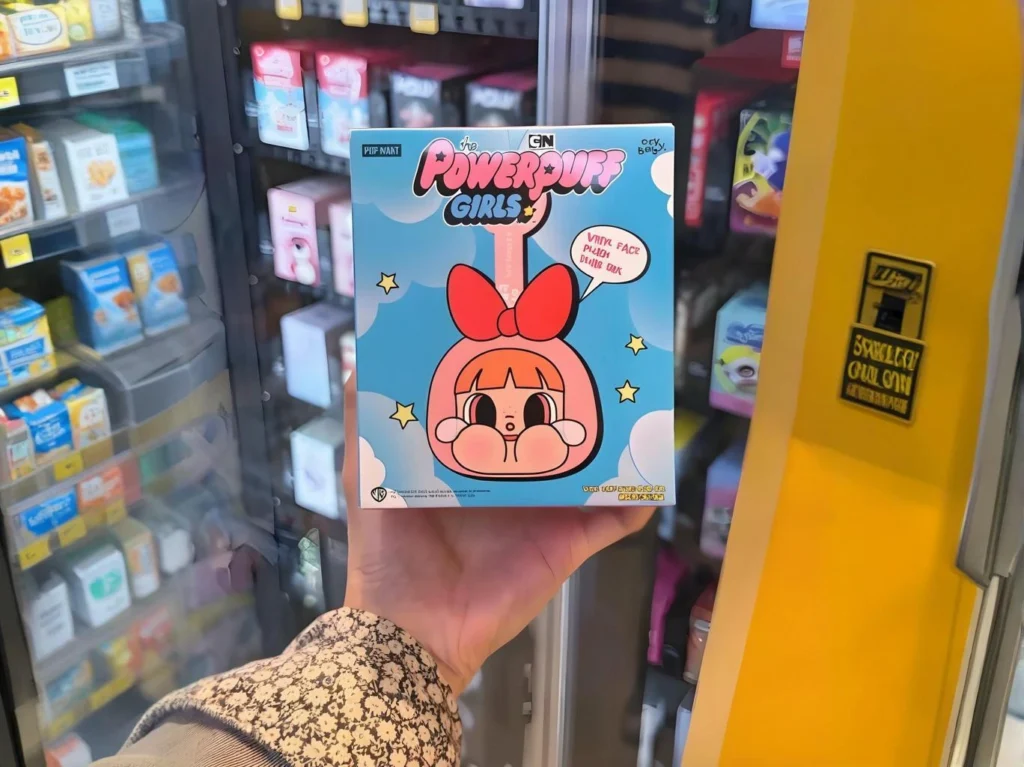
Pop Mart’s supply is intentionally tight. New Labubu figures are frequently “instant sell-out” events, both in retail stores and online. For example, in June 2025, every Labubu keychain or plush release sold out immediately, even provoking scuffles among eager fans.
Second-hand prices soar: a Labubu keychain, originally ¥99 (US$15), was resold for over ¥300, and hidden variants went for ¥3,000. At auctions, rare Labubus have fetched astronomical bids – one special mint-green Labubu sold for ¥1.08 million (US$158k) in June 2025.
This deliberate scarcity fuels hype: by making regular buyers feel they might miss out, Pop Mart multiplies demand.
Omnichannel Retail & Pop-Up Events
Labubu’s demand is met through Pop Mart’s expansive retail network, and by mid-2025, Pop Mart operated 200 branded stores worldwide, plus 2,500 “Robo-Shop” vending machines in malls and transit hubs. These physical locations are more than shops – they are fan hubs.
New releases trigger long lines (e.g., a Kuala Lumpur grand opening saw fans lining up overnight). Physical stores often host unboxing parties, limited-edition pop-ups (e.g., the launch of a Paris Louvre art series), and themed decorations.
Pop Mart has aggressively expanded overseas and plans to open 10 more locations by the end of 2025, thereby establishing a Western presence as well. All told, brick-and-mortar and digital channels (including the official website, Tmall, and JD.com) create multiple touchpoints where Gen Z can discover, purchase, and share Labubu.
Collaborations and Co-Branding
Pop Mart regularly partners with Labubu and major brands to keep interest fresh. For example, they have released Labubu x Hermès bundles (a Labubu with a tiny Hermès bag at auction) and a limited “Monsters Art” series inspired by famous artworks.
More broadly, Pop Mart’s collaborations encompass Disney, Harry Potter, Marvel, Sanrio, and other global IP brands. However, Pop Mart is selective: each collab must have cultural cachet and fit its toy format.
These tie-ins both attract outside fans and reinforce Labubu’s positioning as a fashion-forward accessory (a Disney x Labubu keychain, for instance, might sell to both Disney and Labubu fans).
Social Media and Influencer Adoption
Perhaps most crucially, Pop Mart’s marketing has been almost entirely viral and organic. Massive exposure came when global celebrities, including BLACKPINK’s Lisa, Rihanna, Dua Lipa, and even David Beckham, were spotted with Labubu charms on their bags.
Pop Mart did little paid promotion; instead, social media “unboxing” videos and fashion posts did the work. On TikTok and RedNote (also known as Little Red Book), millions of posts feature Labubu unboxing videos, styling tips, or trades.
This user-driven buzz made Labubu a cultural token – a status symbol akin to luxury streetwear or rare sneakers. Pop Mart leverages this by hosting fan communities and encouraging content: weekly blind-box events, fan clubs, and mini-conventions (even online livestream auctions) keep collectors engaged and talking.
Product Line Expansion
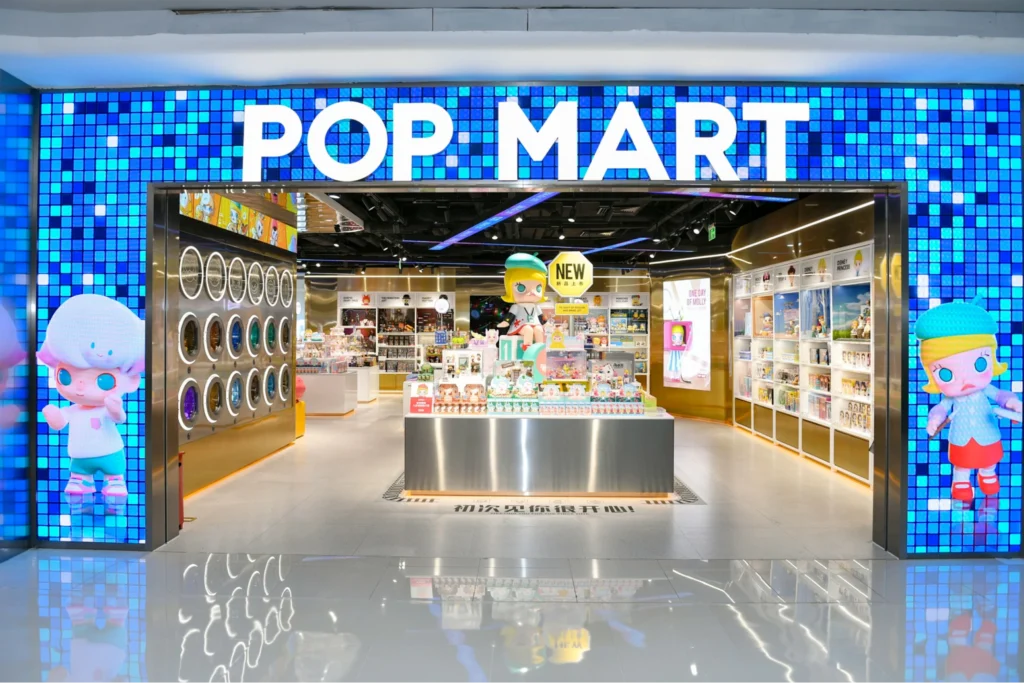
Riding Labubu’s success, Pop Mart quickly broadened its offerings. Originally a small plush doll, Labubu now appears in dozens of variants (3.0 “Dopamine” color line, keychain plush hybrids, giant statues, etc.).
In 2025, Pop Mart launched a “mini Labubu” phone charm model. It also expanded Labubu apparel and art books, cementing the character beyond a single toy. At the same time, Pop Mart expanded its plush product offerings – in 2025, it released over 20 new plush lines, aiming to replicate Labubu’s fashion appeal.
Each element above shows Pop Mart thinking beyond simple toy sales and instead marketing Labubu as a lifestyle brand.
The result? Pop Mart’s CEO Wang Ning, in August 2025, boasted that meeting ¥30 billion (US$4.18B) revenue in 2025 “should be quite easy” – a striking target that hinges heavily on Labubu-driven lines (he’d already reported a tripling of stock price and 200%+ profit jump following the craze).
Rise of Labubu: The Emotional Appeal and Gen Z Collector Culture
Labubu’s surge taps into deep psychological and cultural currents among young consumers, especially in China. The character and buying experience resonate with several key trends:
“Emotional Consumption” Over Utility
Many analysts note that Chinese Gen Z now spend on “情绪消费” (emotional consumption) – purchases made for feeling and identity, not necessity. Labubu embodies this: it is not helpful or pedagogical, but it provides joy, belonging, and self-expression.
As one observer puts it, most people “pursue ‘emotional value’” – Pop Mart simply “洞悉人性” (understands human nature) and sells products for that emotion. Young buyers liken unboxing a blind box to a dopamine hit. They are drawn to the thrill of surprise and the comfort of a cute toy amidst the stress of modern life.
In practice, Labubu, as a cute-rebel figure, gives daily psychological “小快乐” to owners – a little thrill to ward off boredom or anxiety. When top Chinese youth outlet Southern Weekly asked a young collector why he spends over ¥1,000/month ($6.68 USD per month) on blind boxes instead of saving for a house, his answer was blunt: “You could worry about a mortgage tomorrow; I’d rather be happy today”.
Identity, Style, and Belonging
Labubu also serves as a badge of membership in a global trend. Pop Mart reports that its fan base is 70% female and mostly aged 18–30. These are digital natives raised in affluence – they crave novelty, community, and outlets for self-expression.
Hanging a Labubu charm on a bag or wearing Labubu apparel signals personal taste; yet because so many others do the same, it simultaneously provides a sense of group belonging. As one social commentator notes, it’s striking how many young consumers today – despite owning identical mass-market iPhones or sneakers – think they stand out by adding “alternative” accessories.
“Billions of people with the same iPhone… hang a Labubu doll on their bag, and believe they’re being unique and part of a cool circle at once”. In other words, Labubu lets people feel special and safe simultaneously.
Gambling Thrill and Limited Resources
The blind-box model satisfies a pseudo-gambling urge. In China and much of Asia, legalized gambling is largely prohibited, so “blind boxes” become a socially acceptable way to bet on chance. Buying Labubu is in part “下注运气” – betting on luck for an adrenaline rush, not unlike gacha or slot machines. This taps into Gen Z’s appetite for instant excitement.
At the same time, young Chinese have been frustrated by high housing prices and long working hours, fostering a “live-for-today” ethos. Splurging on Labubu can be a minor rebellion against economic pressure – a way to “hug” happiness money without entirely blowing the budget.
Community and Social Media
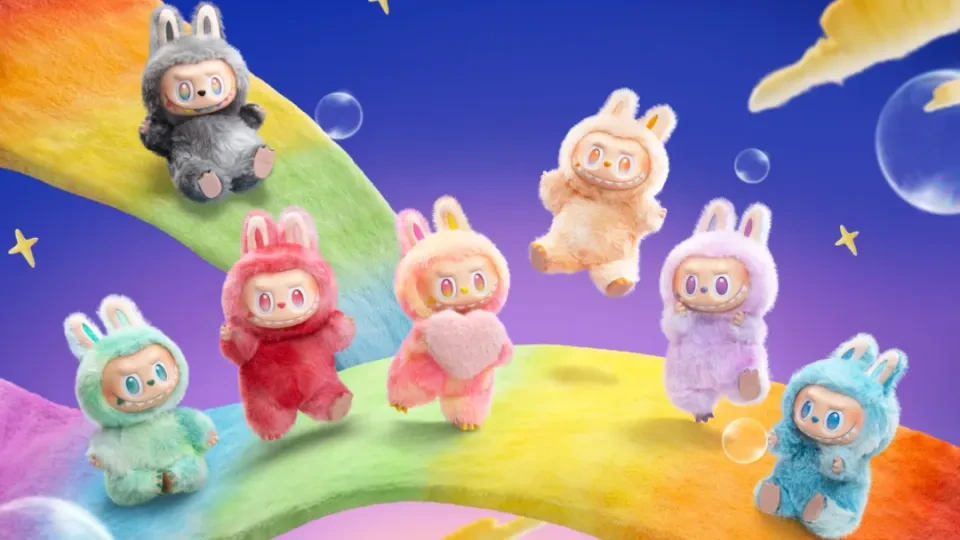
Pop Mart consciously fostered a collector community. Fans swap repeats in WeChat groups and QQ circles, treat rare figures like trading cards, and showcase their collections online. The brand’s presence on social media and livestream e-commerce is huge: TikTok Shop alone has created “incredible momentum” for viral unboxing sales.
Platforms like RedNote serve as style magazines for these toys, where users post photos of Labubu stylized in home decor or street fashion. Offline, Pop Mart stores and events function as conventions: people line up for releases, attend fan gatherings, and even get tattoos of the character on themselves (as seen in Thailand). In short, buying Labubu is a highly social act, not a private purchase.
Global Kidult Trend
Labubu’s appeal isn’t limited to China. Collectible toys have become a “kidult economy” worldwide. As one retail analyst observes, adults now drive more toy sales than children (the 18+ market was $13.9B in the U.S. in 2024, projected to reach $38B by 2034).
Pop Mart executives note that fashion-conscious consumers in the West are increasingly embracing cute designer toys. Labubu’s aesthetic – part Harajuku kawaii, part punk elf – hit a sweet spot for international fans too, especially when Western celebrities (Rihanna, Katy Perry, NFL stars) made it visible abroad.
In summary, Labubu became trendy not by functional necessity but by resonating with values and feelings of a tech-savvy generation: emotional comfort, self-expression, and the thrill of surprise. As China’s “emotional economy” grows – with major brands now investing in sentiment-driven products – Labubu stands as a poster child for that shift.
Sales Surge and Market Impact
The Labubu phenomenon has translated into staggering business results for Pop Mart, dramatically altering its market standing:
Revenue Explosion
Pop Mart’s revenues skyrocketed following Labubu’s rise. According to Pop Mart’s annual reports and media analysis, The Monsters series (Labubu’s franchise) brought in ¥3.0 billion in 2024 (US$418M), a 726.6% year-on-year jump.
In practical terms, Labubu surged from a minor IP to become the single most significant contributor, accounting for 23–35% of Pop Mart’s total revenue at its peak. For perspective, Pop Mart’s total 2024 sales were roughly ¥13.04B (US$1.81B), meaning Labubu’s share was nearly one-quarter of the whole.
The jump continued into 2025. In just the first half of 2025, The Monsters series (with Labubu) did ¥4.81B (US$670M) – about 35% of all Pop Mart revenue. The broader plush category (fueled by Labubu, Jillie the Hamster, and others) grew a dizzying 1,200% in 2025, reaching ¥6.13 billion (US$854 million) in H1.
By mid-2025, Pop Mart’s H1 revenue was up 204% over 2024, and net profit jumped 362% – gains largely attributable to Labubu-driven sales.
Market Capitalization
Investors have taken notice. After Labubu mania hit, Pop Mart’s market cap soared. By mid-2025, it exceeded US$50 billion, making it more valuable than U.S. toy giants Hasbro and Mattel and even Japan’s Sanrio (creator of Hello Kitty).
Founder Wang Ning became one of China’s top ten billionaires on the strength of this growth. Its Hong Kong–listed stock price quadrupled in 2024 alone.
Geographic Shift – Overseas Growth
Pop Mart’s expansion isn’t limited to the domestic market. The company aims to derive 65% of its revenue from overseas by 2027. By Q1 2025, overseas sales had already increased by 475% year-over-year.
Remarkably, Wang reports that North America and the rest of the Asia Pacific combined will soon equal China’s own sales. As of mid-2025, approximately 40% of Pop Mart’s revenue came from outside China, as reported in China.
In the Americas, H1 2025 revenue jumped 1,100% (to ¥2.26B, US$315M), and the store count rose from 20 to 41. This global demand validated Pop Mart’s vision of exporting not just goods but the experience of “emotional consumerism” worldwide.
Record-Breaking Events
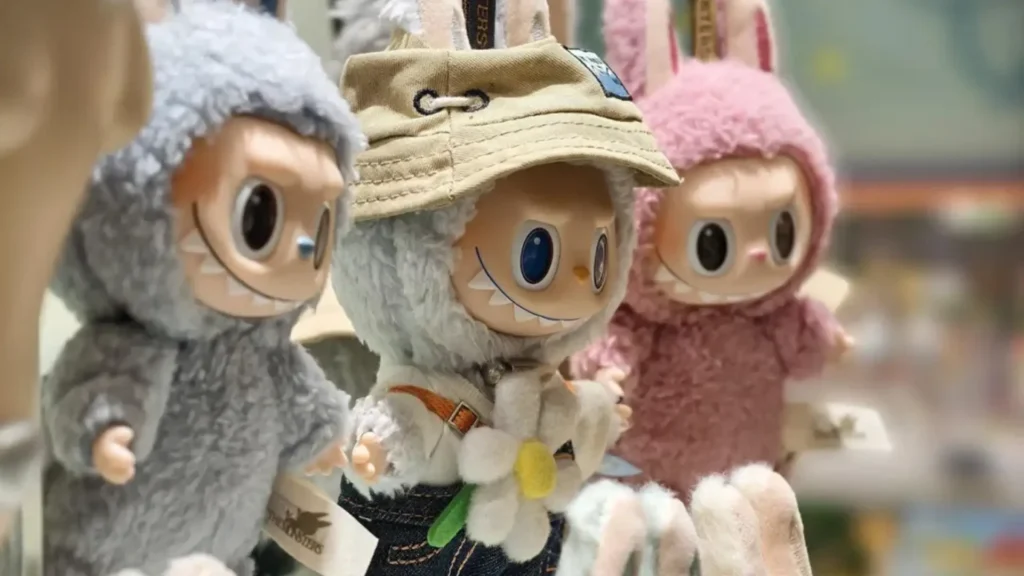
Labubu also became the center of pop-cultural milestones. In June 2025, a customized Labubu auction at Beijing’s Yongle house smashed records: a “first-edition” mint-green Labubu sold for ¥1.08 million.
Pop Mart reported that in the first half of 2024, the Labubu line alone generated ¥6.3 billion in sales – a figure unheard of for a plush doll brand. These figures dwarf most collectibles: Pop Mart sold $670 million of Labubu merchandise in H1 2025, outpacing sales of Barbie ($374 million) and Hot Wheels ($626 million) in the US for the same period.
Demographic Reach of Rise of Labubu
Survey data and marketing analyses confirm Pop Mart’s core audience. Approximately 70% of Pop Mart’s buyers are aged 18–30, and about 60–70% of these are female. However, the products also appeal to students, creative professionals, and even male streetwear fans.
By offering a range of price points – from approximately ¥59 for a single blind box to ¥ 10,000 and above for designer statue collections – Pop Mart engages both casual hobbyists and affluent collectors. Social-media-driven “unboxing” has also attracted younger teens to the fold, expanding the fan base.
In sum, Labubu transformed Pop Mart from a growing niche player into a significant global toy brand. Its success drove record revenues, profits, and market value, while demonstrating that China can export not only manufacturing but cultural products that resonate worldwide.
Labubu vs. Other IPs and Competitors
While Labubu stands out, it is helpful to compare its marketing to other Pop Mart franchises and industry peers:
Within Pop Mart – Molly, Skullpanda, etc
Pop Mart’s earlier hits, such as Molly (designed by Kenny Wong) and Skullpanda, have already established the brand’s collectible culture. However, Labubu’s growth was unprecedented. For example, even though Molly had been Pop Mart’s revenue leader, by 2024 “Monsters” (Labubu’s series) overtook Molly: it grew +720% to ¥3B, surpassing Molly’s sales.
Skullpanda (a dog-of-all-trades figure) and Crybaby also had strong followings, but none enjoyed the same explosive celebrity cachet or global viral momentum. Pop Mart itself notes that each IP has carved its own niche (Skullpanda’s “warmth” theme, Crybaby’s youthful angst, etc.).
Still, Labubu’s “ugly-cute, back-to-nature” look and Western appeal gave it a broader pop icon status. In practice, Pop Mart employed a similar “drop” strategy across all lines (surprise releases, limited editions, and artist collaborations), but Labubu’s keychain plush variant was especially popular.
Pop Mart’s introduction of a soft-plush version of Labubu in late 2023 (a departure from its usual vinyl figurines) unexpectedly exploded in popularity. This success has prompted the company to diversify more plush releases (20+ new plush lines in 2025), trying to replicate Labubu’s mix of softness and sculptural detail.
Competing Blind-Box Brands (Western & Eastern)
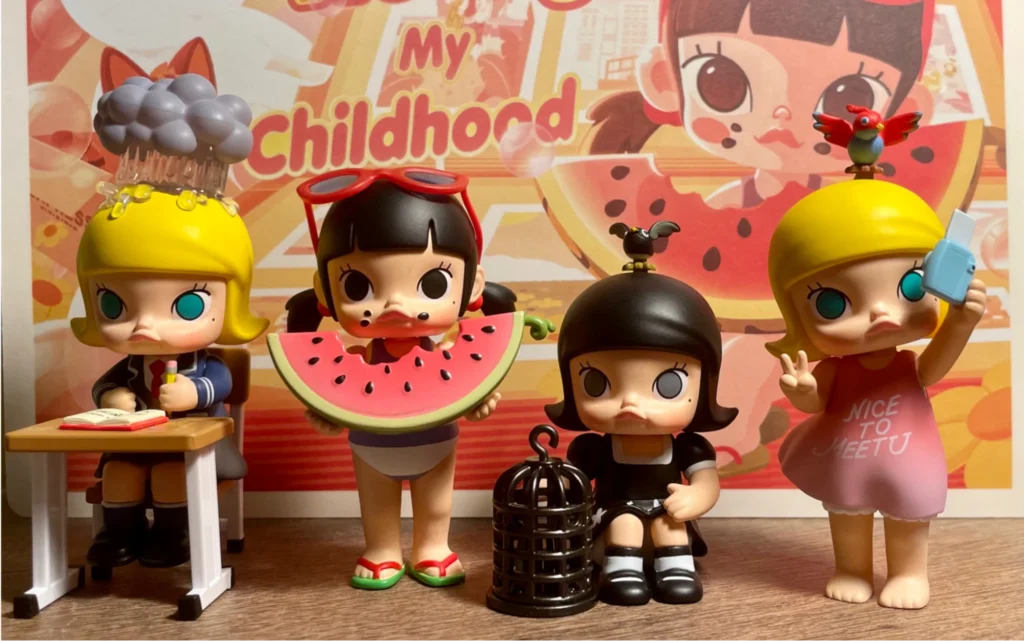
Outside Pop Mart, blind-box collectibles are a global trend. In Japan and the US, “gacha” toys and brands like Funko (Pop! vinyls) or Mighty Jaxx produce rare-variant figures. Disney Parks have their own mystery-box merch, and even major sneaker and streetwear lines (Nike SNKRS, Supreme) use drops.
However, Pop Mart’s key difference lies in its original IP and emotional marketing. Unlike Disney’s licensed characters, Labubu isn’t a legacy cartoon; it’s a new character built from scratch (much like how original game characters or anime heroes are made).
Pop Mart doesn’t just sell a license – it actively shapes Labubu’s character, community, and story. For example, Pop Mart is already planning to turn Labubu into an animated series (“Labubu and Friends” registered in 2024) and is even exploring theme parks, a Disney-like expansion. Few competitors operate on that integrated IP plan.
Pop Mart vs. Big Toy Giants
By mid-2025, Pop Mart’s market cap eclipsed that of many Western toy stalwarts. This reflects not only Labubu’s lift but the changing collector market. While brands like Lego or Barbie focus on product lines or licensed sets, Pop Mart’s model is closer to streetwear brands like Supreme: limited drops that become collectible in their own right.
The Retail TouchPoints analysis draws the analogy explicitly: Pop Mart toys function “the same way sneakers, designer bags, or streetwear drops do – they’re limited-edition, they hold value and they build community”.
Innovation in Distribution and Digital Reach
Another comparison is how Pop Mart sells. Unlike traditional toy companies, Pop Mart uses vending machines (“Robo Shops”) and livestream shopping extensively. This is still novel globally. For instance, in the US, blind-box culture is primarily found on the street/online; Pop Mart introduced Robo Shops and pop-ups in U.S. malls between 2022 and 2025 (e.g., a flagship store at the American Dream mall).
It also heavily leverages Chinese e-commerce innovations, integrating its online platform with social feeds, user-generated content, and stories, mirroring how Chinese brands utilize WeChat and livestreaming platforms. In this sense, Pop Mart’s approach to marketing Labubu has been bolder and more tech-savvy than many Western competitors.
Luxury vs. Fast-Fashion Framing
Some critics debate whether Labubu is a cultural icon or just an addictive scheme. Pop Mart adopts a luxury analogy: its store openings are likened to fashion events, limited editions are compared to haute couture, and fans are likened to luxury collectors.
In fact, retailers have deliberately styled plush Labubu dolls as “high fashion” accessories. However, others caution that the blind-box model has gambling aspects and may exploit addictive tendencies. Pop Mart counters by expanding Labubu’s use cases (e.g., phone charms, cartoon) and by stressing the creative/artistic value behind its IP.
In summary, Labubu’s success is not solely due to novelty, but to Pop Mart’s concerted strategy: focusing on original character design, tight IP control, hype-driven marketing (celebrities, drops, scarcity), and a deep understanding of youth culture.
When compared to Pop Mart’s other IPs (Mrather to Pop Mart’s concerted strategy, which focuses on original character design, tight IP control, hype-driven marketing (utilizing celebrities, drops, and Skullpanda), and outside competitors, Labubu stands out as a case where all these elements aligned spectacularly.
Ready to Unlock Deeper Insights from Rise of Labubu and China’s Digital Revolution?
If the rise of Labubu taught us anything, it’s that emotional connection, scarcity, and bold storytelling can turn a niche product into a global cultural symbol. But what about transforming your brand strategy — from China’s lessons to your market?
Work with Ashley Dudarenok
Leverage the expertise of a serial entrepreneur, China market insider, and award-winning digital strategist. Ashley collaborates with brands, executives, and organizations to develop future-proof strategies grounded in China’s rapidly evolving digital landscape.
Book a consult to explore how these trends — whether emotional consumption, scarcity-driven drops, or channel expansion — can be adapted to your business.
Subscribe to Ashley’s bi-weekly China Insights Newsletter for direct access to reports, trend highlights, and early previews.
FAQs for the Rise of Labubu
1. How can I verify whether a Labubu is authentic or counterfeit?
You can verify authenticity via Pop Mart’s built-in verification feature: most new Labubu boxes include a scratch-off code and a QR code that links to the official Pop Mart site for verification.
Also, inspect the figure’s sculpt quality, crisp paint, correct number of teeth (nine, not eight or ten), packaging with a matte finish (not overly glossy), and matching serial numbers on the tags. Copies (like “Lafufu”) often fail these checks.
2. What are the common counterfeit Labubu names or imitations to watch out for?
Collectors frequently warn against fakes marketed as “Lafufu,” “Lagogo,” “Labubu clone,” or “Labubu variant” with weird spelling. These often have crooked faces, rough texture, mismatched colors, and poor printing on tags. Some high-end fakes can be difficult to spot, so always cross-check the QR code and official branding.
3. Why do counterfeit Labubu products proliferate globally?
Because Labubu enjoys extreme demand and frequent sellouts, many buyers resort to third-party sources. That vacuum allows counterfeiters to flood markets, especially via cross-border e-commerce, street vendors, and unauthorized pop-ups. Some factories operate globally with complex supply chains, making enforcement more challenging.
4. How has Pop Mart responded to the counterfeit problem?
Pop Mart has ramped up its anti-fake measures, including strengthening verification systems, introducing engraved tags and UV stamps on the soles of newer editions, and publicizing lists of authorized sellers. Some cities’ consumer protection offices also require the brand to publish a unified verification portal.
5. What is “祖国版” (domestic edition) of Labubu, and how is it different?
The term “祖国版” refers to Labubu versions meant for sale within mainland China, often with simplified packaging, regional distribution, or slightly different manufacturing tolerances. Some buyers abroad attempt to import them. However, the core design generally remains the same; the main differences lie in labeling, packaging, and distribution channels.
6. What is the typical price range for common vs. rare Labubu figures?
Standard blind-box Labubu keychains typically retail in China for ¥59–¥99 (RMB), depending on the series and material. However, hidden or chase variants and large statues can resell for many times that amount, in rare cases, reaching hundreds of thousands of RMB at auction.
7. Why do buyers sometimes find their Labubu defective or misaligned?
Because Pop Mart mass-produces batches, some units may occasionally have manufacturing defects, such as misaligned limbs, tilted heads, or paint bleed. High hype makes buyers less forgiving — collectors often exchange or return flawed units. Also, some fakes exaggerate defects to pass off as “deliberate style,” complicating judgment.
8. Can I register or list my Labubu collection with Pop Mart’s official platform?
Yes. Pop Mart encourages collectors to register their figures in its official app or website, applying serial numbers and organizing a digital “catalog.” This helps with authenticity tracking, trade, resale, and even potential loyalty rewards or verification badges.
9. How do regional restrictions affect Labubu’s availability overseas?
Some countries have import regulations, customs restrictions, or safety certification requirements (such as CE or UKCA) that can delay or block shipments. Additionally, Pop Mart may restrict certain editions or variants to specific regions, meaning some models may never officially reach your market. That scarcity fuels cross-border demand and secondary trading.
10. Why do some buyers miss Pop Mart’s “Pop Now” or flash-drop features?
Pop Mart often uses flash-drop systems (e.g., “Pop Now”) where a limited number of Labubu are released at unpredictable times. If you’re not logged in, your connection is slow, or your region is blocked, you might miss the chance. Collectors often set alerts or auto-purchase tools to catch drops.
11. How do trade groups and fan swaps support Labubu collecting?
In many countries, local fan clubs or WeChat/Discord groups host swaps of duplicate figures, especially common ones. This allows collectors to complete a series without repeatedly purchasing blind boxes. They also share alerts, localized buying tips, and authenticity checks. The community supports itself.
12. Are Labubu secondary market prices stable or volatile?
They tend to be volatile. Prices for rare or chase pieces can spike dramatically soon after release and then recede. Some editions retain their value in the long term (especially artist or milestone variants), but many see declines once more supply or competing models become available. It’s speculative rather than consistent.
13. Does Pop Mart ever retire or discontinue specific Labubu lines?
Yes. Pop Mart sometimes phases out older series or variants to make way for new themes. Once a line is retired, its remaining units become scarce, which can increase collector demand. Fans closely track official announcements and “last-chance” sales.
14. Can Labubu figures be customized or repainted without losing value?
Customization is standard, including repainting, accessories, and minor sculpt tweaks. However, extreme modifications often reduce the resale value, unless they are done by a well-known artist. Collectors tend to favor original condition. If customization is mild and reversible, the value impact is lower.
15. Why do some Labubu auction results reach prices vastly above retail?
Because specific models become cultural artifacts. At auction, rarity, provenance (including first editions and artist-signed items), condition, and demand all amplify prices. Some buyers treat these sales as status or investment moves. The mystique around celebrity association or milestone versions further inflates value.

